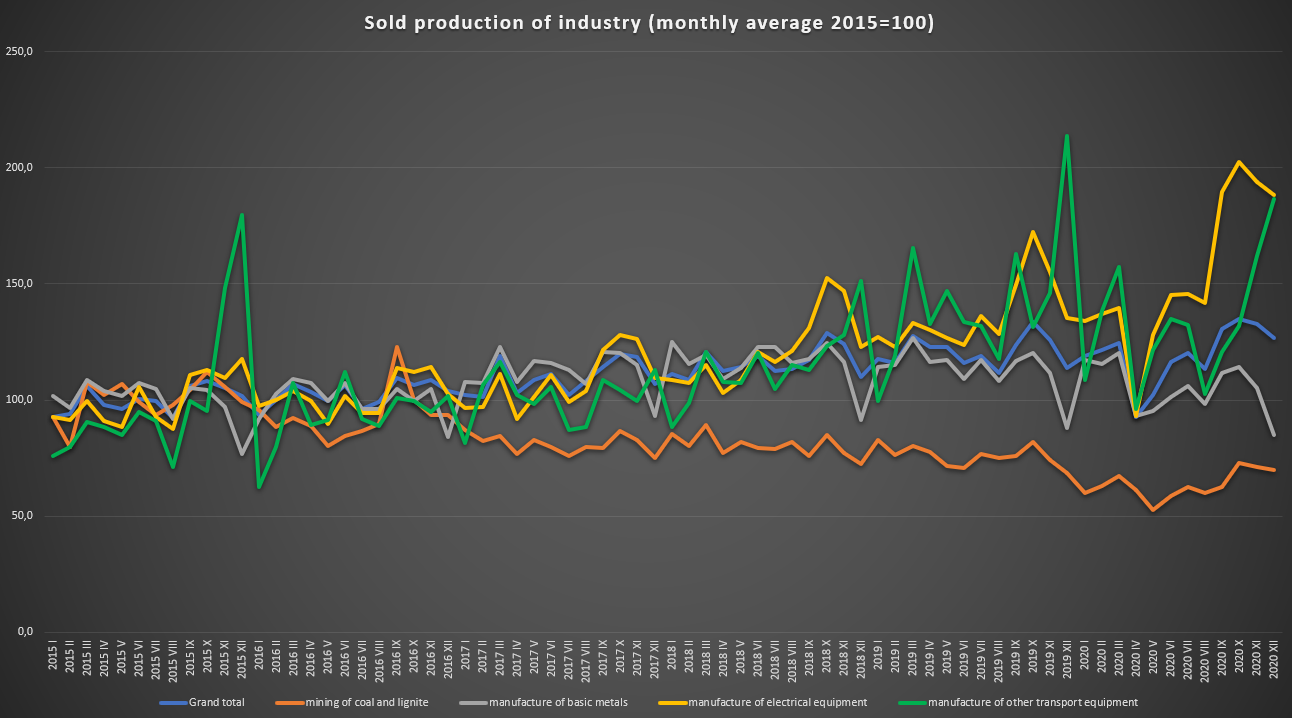Industrial production - one of the most important macro indicators
Industrial production is one of the most important macroeconomic indicators. Some readers may find it surprising. Quite often it is alleged that the indicator is of little importance because services have the highest share in GDP. However, industrial activity is very sensitive to changes in interest rates and changes in market demand. For this reason, some analysts use the industrial production index as one of the "tools" to forecast future change Gross Domestic Product.
Below is a chart of seasonally unadjusted changes in sold industrial production in 2011-2020. The huge drop in production visible in April and May 2020 was due to the impact of COVID-19 (lockdown, interruption of supply chains, etc.) and heralded the contraction of the entire economy in the second quarter of 2020.
Industrial production - who publishes the data?
The Central Statistical Office publishes monthly data on the sold industrial production. It is one of the most important monthly indicators concerning the condition of the Polish economy. This is due to the opinion that this macroeconomic measure is "leading". This is due to the fact that the industrial sector is "integrated" into the global supply chain. As a result, it reacts faster to changes in the global macroeconomic environment.
It is also worth noting that large economic entities dominate among industrial enterprises. This is due to economies of scale which "naturally" lead to consolidation in industrial sectors. This is in contrast to a fragmented service sector (e.g. small hairdressers, cosmetics). For this reason, the industrial production sold index is easier to calculate.
The measure concerning the value of sold production of industry is published by the Central Statistical Office on each 14th working day, each month. This means that the retail sales data for December 2020 was published on January 22, 2021. Such a “slippage” is necessary for the Central Statistical Office to control the data and, in case of doubts, to clarify it and correct errors.
Enterprises employing at least 10 employees have a monthly reporting obligation. Branches of foreign companies as well as state and local government companies and cooperatives are also under the obligation. All industrial companies are required to submit reports for annual reporting.
Monthly reports are submitted by all industrial companies with at least 50 employees. In the case of companies with 10-49 employees, companies are selected for the study on the basis of a representative sample.
Data is collected from entities that operate in the following sectors:
- Mining and extraction;
- Electricity, gas, hot water production and supply, etc .;
- Industrial processing;
- Water supply, sewage and waste management and remediation.
How is the industrial production index calculated?
However, industrial production is not a perfect indicator, and it has its drawbacks as well inflation or average salary. This means that the index does not perfectly reflect the condition of the industry in a given country or region. It is a kind of "down" look at the situation in the industrial sector. The Central Statistical Office does not receive information about every pin, paving stone or metal screw produced. The sold production index of industry is based on the DG-1 form, for its calculation it is necessary to provide the following data:
- Value of products sold outside the enterprise;
- Value of manufactured products not classified for sale, treated as equal to sale;
- An agent's lump sum payment for the business activity entrusted to him;
- excise tax;
- specific subsidies.
To the value of the products sold outside the enterprise include, among others finished products, semi-finished products and parts of own production. Provision of construction and assembly services without the help of subcontractors. This measure also includes research and development or design works.
Manufactured products not included in sales (treated as equal to sales) include own products that go to the own sales network (retail, wholesale, or own catering establishments). This category also includes products included in the own value of fixed assets. It is also worth adding that this category also includes production intended for own employees.
The formula for calculating the ratio has the following value:
Sa = Sw + Sz - Da + Dp where:
- Sa - value of sold production of industry (current prices);
- Sw - revenues from the sale of products and the agent's lump sum payment;
- Sz - costs of producing services for the entity's needs (eg value of products already produced, but not included in sale);
- Da - excise tax on products of own production;
- Dp - specific subsidies (received for products).
The value of sold production is expressed in actual market prices obtained by the production company. The prices do not include VAT and excise duty. However, GUS reports are presented at constant prices. As a result, the industrial production index takes into account the real change in industrial production.
Data on the sold production of industry are presented in absolute numbers, being the value in current basic prices. But in monthly reports, the CSO presents industrial production dynamics calculated in constant prices. Once every 5 years Central Statistical Office converts the values of sold production into new constant prices. New prices are taken from the year ending with 0 or 5. Until the end of 2020, constant prices were calculated for 2015.
Sectors
The Central Statistical Office in its monthly reports divides industrial companies into 29 groups. Among them are, among others producers of food products, beverages, tobacco products or coal mining.
The aforementioned list is an interesting statement that defines the condition of individual sectors and structural changes in the economy. Below is a list of selected economic sectors in 2015-2020. The production of other transport equipment and electrical devices developed very well. There is also a slow decline in hard coal and lignite mining.
Industrial production and the investor
Monitoring industrial production may be an interesting idea for investors who want to "catch" the moment of economic slowdown, which will be visible "in advance" in the industrial sector. At the same time, the analysis of individual sectors will make it possible to compare the results of an industrial company with the entire sector in which the company operates. Another added value is also tracking trends in the economy. This will make it possible to "avoid" investing in "shrinking" sectors and look for investment opportunities in "developing" sectors. Very often there are foundations in favor of shrinking a specific industry. Additionally, even the best companies with great management have a harder time growing in a shrinking market than the average company operating in the sector that is experiencing a boom.






















![Forex Club – Tax 9 – Settle tax on a foreign broker [Download the Application] Forex Club - Tax 9](https://forexclub.pl/wp-content/uploads/2024/02/Forex-Club-Podatek-9-184x120.jpg?v=1709046278)
![Trading View platform – solutions tailored to the needs of traders [Review] trading view review](https://forexclub.pl/wp-content/uploads/2024/03/trading-view-recenzja-184x120.jpg?v=1709558918)
![How to connect your FP Markets account to the Trading View platform [Guide] fp markets trading view](https://forexclub.pl/wp-content/uploads/2024/02/fp-markets-trading-view-184x120.jpg?v=1708677291)
![How to invest in ChatGPT and AI? Stocks and ETFs [Guide] how to invest in chatgpt and artificial intelligence](https://forexclub.pl/wp-content/uploads/2023/02/jak-inwestowac-w-chatgpt-i-sztuczna-inteligencje-184x120.jpg?v=1676364263)






![Izabela Górecka – “Success on the market depends not only on knowledge, but also on emotional stability” [Interview] Izabela Górecka - interview](https://forexclub.pl/wp-content/uploads/2024/04/Izabela-Gorecka-wywiad-184x120.jpg?v=1713870578)
![WeWork – the anatomy of the collapse of a company valued at $47 billion [WeWork, part II] wework bankruptcy story](https://forexclub.pl/wp-content/uploads/2024/04/wework-bankructwo-historia-184x120.jpg?v=1711729561)
![Adam Neumann – the man who screwed up Softbank [WeWork, part AND] adam neumann wework](https://forexclub.pl/wp-content/uploads/2024/04/adam-neumann-wework-184x120.jpg?v=1711728724)


![The most common mistakes of a beginner trader - Mr Yogi [VIDEO] Scalping - The most common mistakes of a beginner trader - VIDEO](https://forexclub.pl/wp-content/uploads/2024/03/Scalping-Najczestsze-bledy-poczatkujacego-tradera-VIDEO-184x120.jpg?v=1711601376)
![Learning patience: No position is also a position - Mr Yogi [VIDEO] Scalping - Learning patience - No position is also a position - VIDEO](https://forexclub.pl/wp-content/uploads/2024/03/Scalping-Nauka-cierpliwosci-Brak-pozycji-to-tez-pozycja-VIDEO-184x120.jpg?v=1710999249)
![When to exit a position and how to minimize losses - Mr Yogi [VIDEO] Scalping - When to exit a position and how to minimize losses - VIDEO](https://forexclub.pl/wp-content/uploads/2024/03/Scalping-Kiedy-wyjsc-z-pozycji-i-jak-minimalizowac-straty-VIDEO-184x120.jpg?v=1710336731)





















Leave a Response